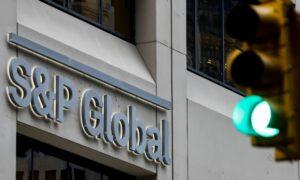S&P Global followed Moody’s lead by downgrading the ratings of five U.S. regional banks by one grade and gave a negative outlook for others.
The credit ratings agency released an Aug. 2 research note citing recent “tough” lending conditions, which led it to cut the ratings of KeyCorp, Comerica Inc., Valley National Bancorp, UMB Financial Corp. and Associated Banc-Corp.
It blamed higher funding costs and sluggish commercial real estate sector, which have put stress on lenders.
The move by Standard & Poor’s comes two weeks after Moody’s cut the credit ratings of 10 regional U.S. lenders and put six large banks on review for potential downgrades, including Bank of New York Mellon, US Bancorp, State Street, Trust Financial, and Northern Trust.
The action earlier this month caused shockwaves across global financial markets and reignited concerns of a looming U.S. recession.
Moody’s warned of “ongoing strain” in the U.S. banking sector, such as increased pressures on funding, and that the amount of capital lenders are required to hold during a crisis may not be enough.
US Financial Sector Under Major Stress
The 2023 U.S. bank crisis and the Federal Reserve’s move to aggressively hike borrowing rates has forced many regional banks to raise deposit costs.The collapse of both Silicon Valley Bank and Signature Bank sparked a loss of confidence in the industry and led to a run on deposits at several regional lenders.
The spike in deposit costs has forced smaller lenders to offer depositors higher interest rates to keep them from moving to higher yielding alternatives, but that has directly cut into their profitability.
Even after offering generous interest rates, many regional banks are still struggling to prevent deposit outflows.
S&P slashed the ratings for Associated Banc-Corp and Valley National Bancorp due to funding risks and increasing reliance on brokered deposits, while citing major deposit outflows and the effect of higher interest rates for downgrading UMB Financial Corp, Comerica Bank and KeyCorp.
The agency cited Comerica’s $14 billion decline in average deposits this year from the second quarter of 2022 as one of the key reasons for its downgrade. S&P also highlighted its “relatively high proportion of commercial and uninsured deposits” in its decision.
The other four banks are facing similar issues, according to the report.
S&P also lowered the outlook of S&T Bank and River City Bank to “negative” from “stable” due to their higher exposure to commercial real estate.
The commercial real estate sector has collapsed, as remote work became commonplace since the pandemic.
This has put severe pressure on small to mid-sized banks, which have disproportionately financed many commercial real estate deals, leading them to potentially suffer losses as a result.
Moody’s noted that many “regional banks have comparatively low regulatory capital versus the largest U.S. banks and global peers.”
Most Lenders Remain Stable, Says S&P
The recent action by S&P will make borrowing more expensive for the troubled industry, especially in the wake of the banking crisis earlier this year.Meanwhile, borrowing costs surged worldwide on Aug. 22 after U.S. Treasury yields hit their highest level in 16 years, as the bond market declined for the sixth week.
However, S&P said that 90 percent of American lenders still have stable outlooks and that only the remaining 10 percent are in negative territory.
Still, none of those rated have positive outlooks, said S&P.
In addition, Chris Wolfe, an analyst at Fitch, told CNBC on Aug. 15 that dozens of banks, including JPMorgan Chase, may face downgrades if the industry’s “operating environment” deteriorated even further.
Fitch controversially downgraded the United States’s long-term credit rating earlier this month, from AAA to AA+, citing the extended fight over the debt ceiling and the skyrocketing federal deficit.
The downgrade was slammed by politicians in Washington and leaders in the banking sector, like JPMorgan CEO Jamie Dimon.







